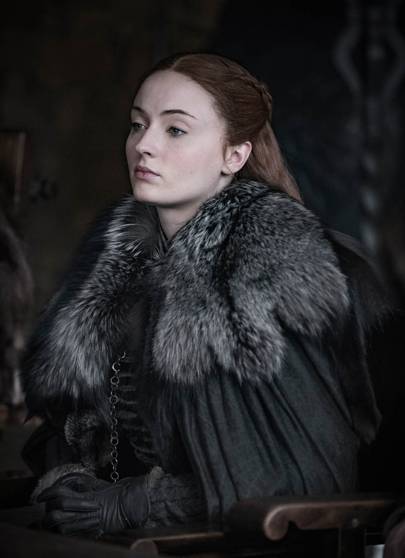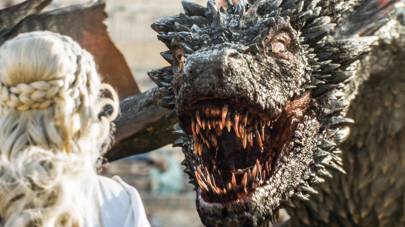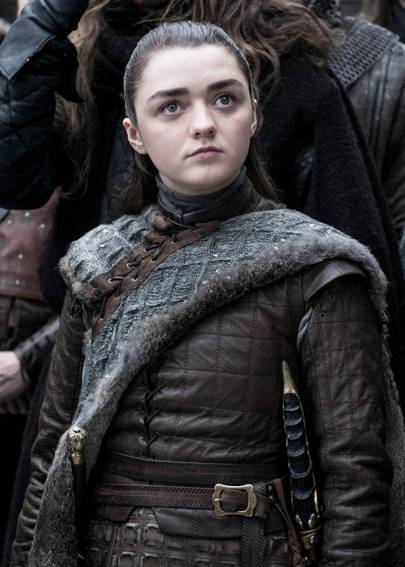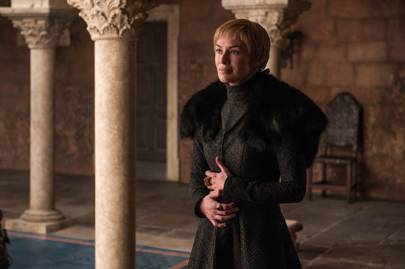
In leafy Dulwich, south London, four stars from Game of Thrones convene in a Georgian house for Vogue. With the sky outside a washed-out grey, the jewel-like colours of their Balenciaga and Givenchy gowns are almost obscenely bright. In the fictional world of Westeros, a mighty gathering such as this would be a prelude to war. After all, these women play four of the strongest characters on the blockbuster HBO series that helped revitalise the TV landscape, launched a thousand water-cooler conversations, won 47 Emmys and turned a generation of British talent, including this foursome, into bankable global stars.
If Game of Thrones proves anything, it’s that it requires full commitment – to gore, intricate plotting and gargantuan world-building – to craft a cultural phenomenon. Same-day viewers quadrupled since the first season, in 2011; cross-platform numbers for the seventh season averaged 30.6 million viewers per episode – more than the populations of Greece and Belgium combined; and for seven consecutive years it was the world’s most pirated TV show. Fans breathlessly pore over every last detail that emerges from the notoriously tight-lipped set, right down to the size of the green screens being used or the choice of crown deployed for each character. The series has dispelled the idea that fantasy is solely for male dweebs. It’s no understatement to say that the forthcoming eighth season – the show’s final six instalments – is the most exciting TV comeback of the year.



Lena Headey, 45, who plays merciless Queen Cersei, arrives first on set in a shaggy faux fur-trimmed Acne coat – a post-Christmas gift to herself, she tells me. Gwendoline Christie, whose 6ft 3in frame led to her casting as noble warrior Brienne, appears in a necklace and dressing gown. “There she is! The lady of the day!” Headey cries. Christie, 40, puts on her best fashion-assistant voice: “When you’re ready,” she demurs, as if about to usher Headey on set. They burst into laughter.
Sophie Turner, 23, now fronting the X-Men franchise with a lead role in Dark Phoenix, shrieks when she sees Headey and zeroes in for a hug: “I haven’t seen you in ages!” Maisie Williams, 21, who turned up earlier in leopard-print Dr Martens, is already on the lookout for Turner. Both young actresses have fan armies of devoted teens who have jointly crowned them #Mophie, but it appears no one is more devoted to the pair than the girls are to each other. “Is she here yet?” asks Williams, letting out an elated cry when she is informed that her best friend from the show is, indeed, present.



The atmosphere is less Red Wedding massacre, more congenial college reunion. The actors have been working together for almost a decade. Thrones is a “big chunk of my existence”, Christie says. Or, as Headey has it even more directly, it’s been long enough for “two children and a divorce”.
Williams and Turner were only 12 and 13 when they were cast respectively as sisters Arya and Sansa Stark, the former a tomboy turned assassin, the latter the brat who matured into the queenly Lady Stark of Winterfell. Their lives have changed in real life, too, of course. Filming aside, Turner is engaged to the musician Joe Jonas, while Williams has launched Daisie, a social networking platform for creatives. “The older ones of us always go, ‘Look, it’s f**king killed us!’” Headey laughs. “Then you watch Maisie, who arrived as a baby, and Soph, who are now these incredible women. It’s just bonkers.”



It’s easy to forget this TV goliath was once a risky proposition. Game of Thrones arrived in 2011, a decidedly unmagical time in entertainment. The Lord of the Rings trilogy had been and gone; the Harry Potter films had just wrapped. Critics turned up their noses at the idea of a fantasy series that combined CGI dragons with Tarantino-style violence and West Wing-level political machinations. “None of us knew,” Headey says. “You do your audition, you get a job and then you think, ‘Will anyone watch this?’”
But they did. After a slow-burning first season, executive producers David Benioff and Dan Weiss set the ratings on fire when they killed off their seeming central lead, Sean Bean’s ill-fated patriarch Ned Stark. Audiences were thrilled to know that nobody on the show was safe – a fact confirmed by subsequent deaths in their multitudes. Beloved characters have been poisoned, stabbed, blown up, eaten by dogs, shot with arrows, starved, beheaded and burnt at the stake. It makes for uniquely stressful viewing, with each instalment of the final season costing a staggering $15 million (episodes of Netflix’s big budget Stranger Things cost $8 million).



As the new season begins, Williams, Turner and Christie’s characters are hunkered down in Winterfell, the ancestral castle of the Stark clan. The army of the dead – led by terrifying supernatural warriors known as the White Walkers – are marching towards them. Further south, Cersei – newly pregnant by way of her long-term sexual relationship with her twin brother, Jaime – is plotting to wipe out the Starks and any other threat to her reign.
Understandably, there is a whiff of battle-hardened weariness to the group. The final season took 10 months to film, including a much-hyped fight scene that was shot outdoors for 55 nights before moving to a studio for further weeks. “All the training in the world couldn’t have prepared me for the amount of stamina you needed for these night shoots,” Williams says. “It gets to the point where it’s four o’clock in the morning and you’re looking around like, ‘This is ridiculous. What are we doing?’”



Such is the secrecy around the show that even the normally garrulous Christie clams up when asked about the battle: “There’s an increasing darkness in Westeros,” she says. Headey is more circumspect about the whole experience. “It’s long hours and hard work,” she says. Amid the exhaustion is pride and a palpable sense of mourning as the action comes to an end. Tears on last days on set were not uncommon. When the time came to shoot Turner’s final scene, she says, “I couldn’t control myself. I cried for hours and hours once it wrapped. It was like leaving behind a character that I’ve grown up with. It’s almost like a death.”
When Game of Thrones premiered, much was made of its no-holds-barred approach to female nudity, rape and violence. Turner’s character, Sansa, in particular, was put through the wringer – she was first betrothed to abusive boy king Joffrey Baratheon, then married off to psychopathic sadist Ramsay Bolton. Her rape at the hands of the latter, in particular, had viewers up in arms. “There are some people who make comments like, ‘It’s a misogynistic show because all these women are getting raped,’” she says passionately. “[But] most of the people coming out on top are women.” Williams agrees: “I’d say the key players this season are all female, which is why it’s so amazing we’re doing this shoot today.”



Thanks to seasons-long narrative arcs, female characters – sometimes given short shrift in cinema – are maturing and developing over time. Brienne, for one, has been a joy to watch. Playing the warrior with a heart of gold has left a deep impression on Christie. “I do see Brienne of Tarth as a modern day Joan of Arc,” she says. Will she consummate her romantic tension with Jaime or the strapping fighter Tormund? “What I will say is, I’m happy to see more of Brienne of Tarth the woman explored this season,” she teases.
Headey maintains that, along with Martin, it was always the producers’ plan to upend the patriarchy of Westeros. “That’s why they could shoulder all of the criticism – they knew what was coming and what they had in store for these women,” she says. Did she ever doubt them? There’s a flash of Cersei-like steel in her look. “No.” Headey would know: she’s had plenty of encounters with overbearing men, having spoken out about the bullying she endured on the set of The Brothers Grimm and a near-miss encounter with Harvey Weinstein (she escaped when the key card to his hotel room didn’t work). What would Cersei do to people like him? “Hotdogs for sale,” she says, smiling.



As a parting gift, each actor was given a storyboard of Weiss and Benioff’s favourite scenes – Headey got the “moment where Cersei sits on the throne and Jaime comes back and sees her”, she says; Turner took the liberty of taking her corset home. “Everyone else has something that runs with them throughout the show, like a sword,” she explains, laughing. “I didn’t have anything that stayed the same except for my corset.”
As for the wrap party? In keeping with the House of Stark’s famous motto, “Winter Is Coming”, HBO booked Snow Patrol to play for the cast and crew in Belfast; footage later uploaded to Twitter shows a tipsy crowd singing along to the show’s distinctive cello theme. “Goodbye, Belfast,” Williams posted on Instagram on the last day of shooting. “Goodbye, Arya. Goodbye, Game of Thrones. What a joy I’ve had.”
Well, not quite goodbye. HBO is already casting an as yet untitled Game of Thrones prequel, set thousands of years before the original, with Naomi Watts signing on to star as a mysterious charismatic socialite. And this isn’t the end for the women of Westeros. Already they’re appearing in each others’ projects – Headey has directed a music video starring Williams for the English singer-songwriter Freya Ridings – and sitting front row together at fashion weeks. Best of all, they even have their own group chat going. “It’s like this big WhatsApp group with David and Dan and all the cast in it,” Turner says. “It’s called ‘Game of Thrones Alumni’.”
“Actually,” she corrects herself, “we changed the name. It’s called ‘Mates’ now.”
See the full shoot in the April issue of Vogue, on newsstands now; the eighth and final season of Game of Thrones begins on April 15 on Sky Atlantic and Now TV.



















![[Book Review] The Blade Itself (The First Law Trilogy) by Joe Abercrombie](https://bendthekneegot.com/wp-content/uploads/2018/01/1516047103_maxresdefault-218x150.jpg)
















